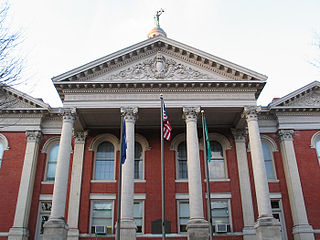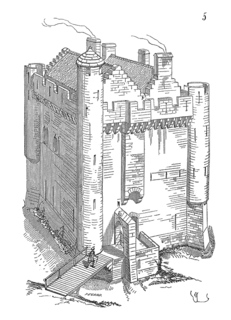
Caroline County is a United States county located in the eastern part of the Commonwealth of Virginia. The northern boundary of the county borders on the Rappahannock River, notably at the historic town of Port Royal. The Caroline county seat is Bowling Green.

Augusta County is a county in the Shenandoah Valley on the western edge of the Commonwealth of Virginia. The second-largest county of Virginia by total area, it completely surrounds the independent cities of Staunton and Waynesboro. Its county seat is Staunton, but most of the administrative services have offices in neighboring Verona.

Point Pleasant is a city in and the county seat of Mason County, West Virginia, United States, at the confluence of the Ohio and Kanawha Rivers. The population was 4,101 at the 2020 census. It is the principal city of the Point Pleasant, WV-OH Micropolitan Statistical Area.

Fort Ashby is a historic stockade fort located in Fort Ashby, West Virginia, US. A military installation constructed during the French and Indian War, it is listed on the National Register of Historic Places.

Benjamin Logan was an American pioneer, soldier, and politician from Virginia, then Shelby County, Kentucky. As colonel of the Kentucky County, Virginia militia during the American Revolutionary War, he was second-in-command of all the trans-Appalachian Virginia. He became a politician and help secure statehood for Kentucky. His brother, John Logan, who at times served under him in the militia and replaced him as delegate, became the first state treasurer of Kentucky.

East Harptree is a village and civil parish in Somerset, England. It is situated 5 miles (8.0 km) north of Wells and 15 miles (24.1 km) south of Bristol, on the northern slope of the Mendip Hills overlooking the Chew Valley. The parish has a population of 644. The parish includes the hamlet of Coley.

Woodlawn is a historic house located in Fairfax County, Virginia. Originally a part of Mount Vernon, George Washington's historic plantation estate, it was subdivided in the 19th century by abolitionists to demonstrate the viability of a free labor system. The address is now 9000 Richmond Highway, Alexandria, Virginia, but due to expansion of Fort Belvoir and reconstruction of historic Route 1, access is via Woodlawn Road slightly south of Jeff Todd Way/State Route 235. The house is a designated National Historic Landmark, primarily for its association with the Washington family, but also for the role it played in the historic preservation movement. It is now a museum property owned and managed by the National Trust for Historic Preservation.

Sir Edward Guy Dawber, RA was an English architect working in the late Arts and Crafts style, whose work is particularly associated with the Cotswolds.

Horningsham is a small village and civil parish in Wiltshire, England, on the county border with Somerset. The village lies about 4 miles (6 km) southwest of the town of Warminster and 4+1⁄2 miles (7 km) southeast of Frome, Somerset.

A fortified house or fortified mansion is a type of building which developed in Europe during the Middle Ages, generally with significant fortifications added.
Colonel John Stuart was a Revolutionary War commander and pioneering western Virginia settler. A veteran of the Battle of Point Pleasant (1774), he surveyed and settled the Greenbrier Valley and is known locally as the "Father of Greenbrier County". Owing to his Memoir of Indian Wars and Other Occurrences, written in 1799, he has been called "the most important chronicler of pioneer history in southern West Virginia".

Fort Van Meter — or Fort VanMeter — is a mid-18th century frontier fort in the South Branch Potomac River Valley about 9 miles (14 km) southwest of Romney in Hampshire County, West Virginia, USA. It is located 15 miles (24 km) northeast of Moorefield and about a mile northeast of the former community of Glebe at the northern end of the rugged river gorge known as The Trough.
Fort Forman was a stockade fort erected by Captain William Foreman at the beginning of the French and Indian War situated three miles north of Romney on the South Branch Potomac River near Vance on West Virginia Route 28. Fort Furman was in use from its construction in 1755 until 1764.

Clover Creek is an unincorporated community in Highland County, Virginia, United States. Clover Creek is located 10 miles (16 km) south-southeast of Monterey, Virginia on State Route 678. The community is situated in the Bullpasture Valley along the path of the Bullpasture River. Beginning in 1897 with a decision by the United States Board on Geographic Names, the community was officially referred to as the single-word "Clovercreek"; however, in 1970, the board modified the community's name to the current two-word "Clover Creek". During the French and Indian War, a British fort named Fort George was built near Clover Creek in 1754 consisting of a wooden stockade 90 feet (27 m) square. The fort was never directly attacked, though arrows were at one point launched against the fort from a distance leaving no damage. George Washington may have visited the fort while traveling in the area, marking the only time Washington visited the region which is now known as Highland County.
Bellwood, also known at various times over the past two centuries as Sheffields, New Oxford, Auburn Chase, and currently as Defense Supply Center Richmond Officers' Club-Building 42, is a historic plantation house located south of Richmond in Chesterfield County, Virginia.

Linden is a historic home located near Champlain, Essex County, Virginia. and is a 2+1⁄2-story, three bay, nearly square, brick dwelling in the Federal style. It has a side gable roof and side-passage plan.

Old Forge Farm, also known as Zane's Furnace, Stephens Fort, and Marlboro Iron Works, is a historic home and farm located near Middletown, Frederick County, Virginia. The original section dates to the 18th century. The house is a two-story, asymmetrical, three-bay, limestone dwelling with a two-story addition connecting the main house to a one-story former summer kitchen. Also on the property are the contributing 18th century hexagonal ice house of unusual design, an early 20th-century root cellar, privy, and shed. The property was first known as Stephen's Fort, built by Lewis Stephens, son of Peter Stephens, for protection during the French and Indian War. Sold in 1767 to Isaac Zane, whose Zane's Furnace was a major manufacturer of munitions for the Continental Army. Grist mill operations continued into the 1950s.
Captain Mathew Arbuckle Sr., was a pioneering hunter and trapper of western Virginia and the Ohio territory. He is considered likely to have been the first white person to travel through Virginia all the way to the Ohio River, other than as a prisoner of the Indians. This trapping and trading trip may have occurred around 1764.
Fort Dinwiddie (1755–1789) was a base for the Virginia Militia during the French and Indian War and Revolutionary War. It was located on the Jackson River, five miles west of Warm Springs, Virginia, in present-day Bath County.

Buffalo Creek is a stream in the U.S. states of Pennsylvania and West Virginia. It rises in East Finley Township, Washington County, Pennsylvania. Its tributaries are Brushy Run, Mill Run, Indian Camp Run, Buck Run, and Dutch Fork. These streams flow through the townships of East Findley, Donegal, Hopewell, and Buffalo, and the creek itself empties into the Ohio River at Wellsburg, West Virginia. The stream was presumably named for a Buffalo trace that once passed through the valley.
















